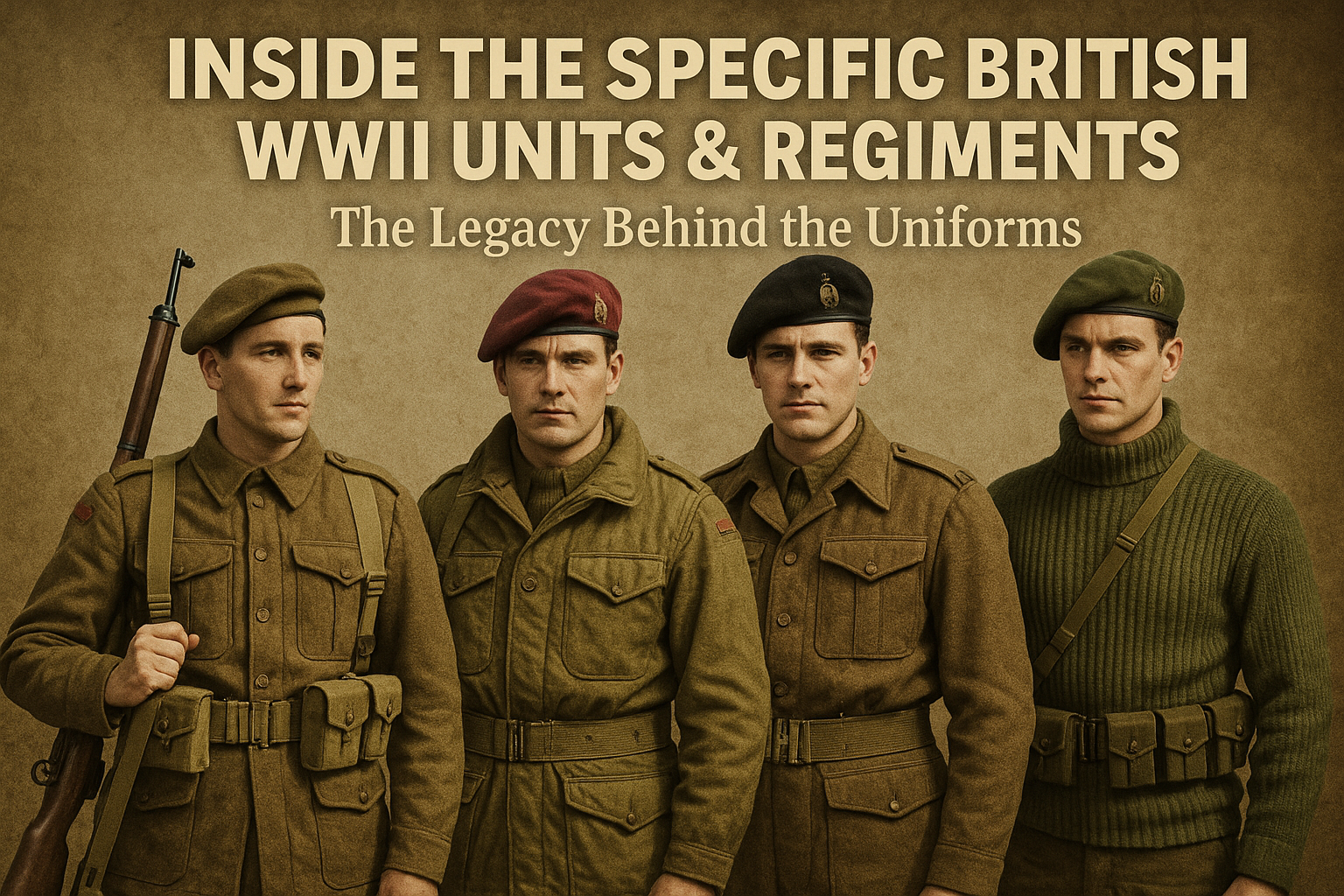
Inside the Specific British WWII Units & Regiments: The Legacy Behind the Uniforms
Published on Apr 27, 2025
Specific British WWII Units & Regiments: The Legacy Behind the Uniforms
World War II was a defining moment in world history, and Britain’s contribution was both heroic and complex. Among the key elements that shaped Britain's success were its military units and regiments — each with its distinct traditions, uniforms, and missions. Understanding these forces not only gives us a deeper appreciation of history but also inspires the preservation of their iconic uniforms today.
If you are passionate about British military history, WW2 English uniforms, and the rich heritage behind British special forces, this article is your ultimate guide.
The Structure of the British Army in WWII
During World War II, the British Army was structured into several types of units:
- Infantry Divisions
- Armored Divisions
- Airborne Divisions
- Special Forces Units
Each of these divisions played specific roles on various battlefronts, from the beaches of Normandy to the deserts of North Africa.
The army’s structure allowed for flexibility and rapid deployment, adapting to new warfare strategies. The UK army uniform also evolved to meet the demands of different climates and combat environments, from heavy wool for European winters to lightweight khaki for desert operations.
Iconic British WWII Regiments
1. The Royal Scots
As the oldest regiment in WWII British Army, dating back to 1633, the Royal Scots held a prestigious role during WWII. Their smart service dress, featuring the traditional tam o’ shatter and khaki battledress, is still highly collectible today.
2. The Parachute Regiment ("The Paras")
Formed in 1942, the Parachute Regiment became famous for their daring airborne assaults. Their distinctive maroon beret and Para smock became iconic symbols of bravery during operations like Arnhem and Normandy.
3. The Royal Tank Regiment
With the increasing use of tanks, the Royal Tank Regiment spearheaded armored attacks. Their black berets and tank suits were designed for practicality inside cramped armored vehicles.
4. The Commandos
Raised in 1940, the British Commandos were elite raiders specializing in amphibious assaults. Their green berets and commando sweaters became trademarks of stealth and aggression.
These regiments’ uniforms were designed with functionality, identity, and morale in mind — key reasons why authentic WWII UK army uniforms remain highly sought after.
The Birth of British Special Forces: Who Created the SAS?
One of the most revolutionary developments of WWII was the formation of the Special Air Service (SAS).
Who created the SAS?
The SAS was founded by David Stirling in 1941. Originally conceived as a commando unit operating behind enemy lines in North Africa, Stirling’s vision was for small, highly-trained groups to carry out sabotage missions, gathering intelligence and undermining enemy operations.
The first SAS soldiers wore modified desert uniforms, incorporating practical elements such as loose-fitting shirts, light trousers, and specially adapted boots to suit the harsh desert conditions.
Today, the SAS remains one of the most respected special forces units worldwide — and its WWII uniforms are among the most prized artifacts for collectors.
Evolution of the UK Army Uniform During WWII
British military uniforms during WWII saw significant evolution to match the diverse theaters of war:
- Early War (1939-1941):
- The army primarily used the Battledress – a practical wool uniform designed for general use. It was warm, durable, and versatile but not ideal for all climates.
- Desert War (1940-1943):
- Forces in North Africa needed lighter gear, leading to the use of khaki drill uniforms, shorts, and solar topees (pith helmets).
- European Theater (1944-1945):
- Modified battledress patterns and specialized uniforms like the Denison smock for airborne troops appeared, focusing on mobility, camouflage, and comfort.
Each adjustment was not just about comfort but a tactical advantage. A soldier’s uniform could mean the difference between survival and failure in extreme environments.
Connection to Earlier British Military History
Looking back to the British army uniform in 1776, the traditional red coats of the 18th century were vastly different from the camouflage-focused gear of WWII.
However, what remained consistent was the British military’s emphasis on identity, pride, and practicality — values that remain central even in today's UK army uniforms.
The evolution from bright red coats to the muted greens and browns of WWII marks the journey of the British Army adapting to modern warfare.
Collecting British WWII Uniforms Today
Original British WWII uniforms are now treasured pieces of history, symbolizing courage and sacrifice. Whether it’s a Paratrooper's Denison smock, a Commando’s green beret, or a desert battalion’s khaki shorts, each piece tells a story.
Collectors and museums alike seek these artifacts for their historical significance and craftsmanship. At Paddelaters.com, we are proud to preserve and offer authentic WW2 English uniforms and reproductions, allowing you to connect with this incredible history firsthand.
Why Understanding Specific British WWII Units Matters
Understanding the nuances between different regiments and units deepens our appreciation for WWII history. Each unit had unique missions, uniforms, and traditions that contributed to the broader Allied victory.
Moreover, the continued use of traditions and regalia from WWII in today’s British Army, including special forces like the SAS, keeps their spirit alive for future generations.
Conclusion
The story of specific British WWII units and regiments is a story of innovation, bravery, and resilience. From the formation of the SAS to the meticulous evolution of the UK army uniform, Britain’s military history during World War II offers lessons in adaptability and courage.
Whether you're a military enthusiast, historian, or collector, preserving and understanding this legacy helps honor those who fought for freedom.
Discover more about British military uniforms and the men who wore them.
